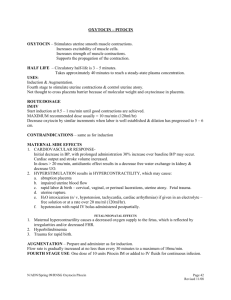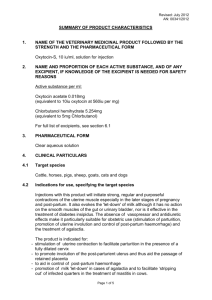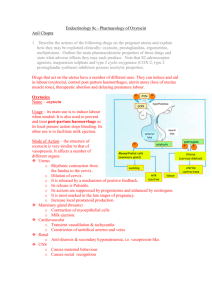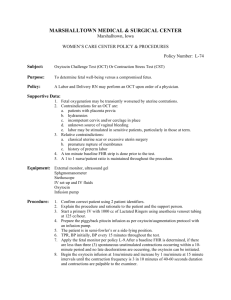Physiology – Initiation of Labour at Term and Before
advertisement
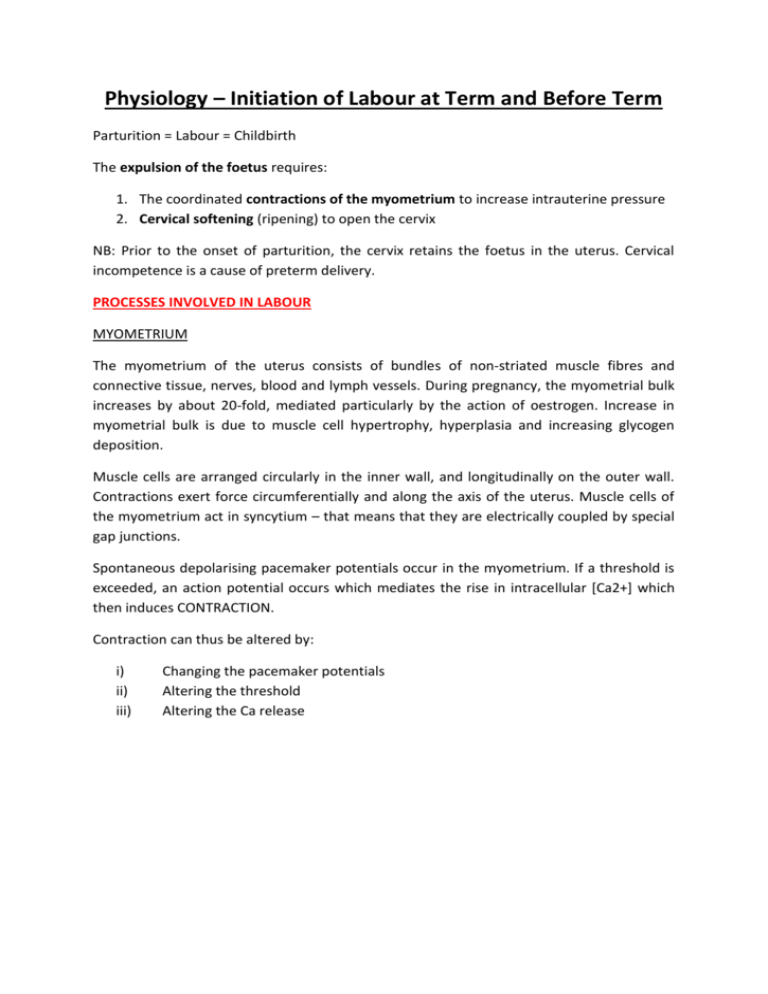
Physiology – Initiation of Labour at Term and Before Term Parturition = Labour = Childbirth The expulsion of the foetus requires: 1. The coordinated contractions of the myometrium to increase intrauterine pressure 2. Cervical softening (ripening) to open the cervix NB: Prior to the onset of parturition, the cervix retains the foetus in the uterus. Cervical incompetence is a cause of preterm delivery. PROCESSES INVOLVED IN LABOUR MYOMETRIUM The myometrium of the uterus consists of bundles of non-striated muscle fibres and connective tissue, nerves, blood and lymph vessels. During pregnancy, the myometrial bulk increases by about 20-fold, mediated particularly by the action of oestrogen. Increase in myometrial bulk is due to muscle cell hypertrophy, hyperplasia and increasing glycogen deposition. Muscle cells are arranged circularly in the inner wall, and longitudinally on the outer wall. Contractions exert force circumferentially and along the axis of the uterus. Muscle cells of the myometrium act in syncytium – that means that they are electrically coupled by special gap junctions. Spontaneous depolarising pacemaker potentials occur in the myometrium. If a threshold is exceeded, an action potential occurs which mediates the rise in intracellular [Ca2+] which then induces CONTRACTION. Contraction can thus be altered by: i) ii) iii) Changing the pacemaker potentials Altering the threshold Altering the Ca release The following diagram illustrates the biochemical pathways to induce contraction in the myometrium: Positive Feedback Pathways Opening of Ca2+ channel leading to increasing levels of intracellular Ca2+ levels. This provides positive feedback on the formation of Myosin light chain kinase to induce contraction of actin and myosin filaments leading to overall contraction of myometrium. Synthesis of PGF from arachadonic acid binds to PGF receptors which provides positive feedback on the formation of intracellular Ca2+ and myosin light chain kinase. Action of oxytocin on its receptor induces positive feedback on MLCK. Negative Feedback Pathways Nitrous Oxide induces the synthesis of cGMP which provides negative feedback on Ca2+ levels and MLCK synthesis. Beta-agonists of parathyroid hormone and parathyroid hormone related peptide lead to the synthesis of cAMP providing negative feedback upon the MLCK. CERVIX Consists of a high content of connective tissue, composed of collagen fibre bundles in proteolyglycan matrix. It is able to resist stretching. The cervical softening involves: i) ii) iii) iv) Decrease in the collagen fibres Increase in levels of glycosaminoglycans Increasing keratan sulphate (which doesn’t bind collagen) Decreasing dermatan sulphate (which binds to collagen) iii + iv induce the loosening of collagen fibres leading to the stretching of the cervix. The CAUSES of cervical softening are: The increase in metalloproteinases in the cervix Influx of inflammatory cells Increase in proinflammatory cytokines (IL-2, IL-8) Increase in iNOS which then induces the increase in concentration of NO (the pharmacological inhibition of iNOS prevents ripening) Prostaglandin presence – This is usually either PGE2 and PGF2α intravaginally or intracervically. They are often used for the induction of labour and late abortion. Prostaglandin inhibitors arrest the premature cervical ripening. NEUROENDOCRINE REFLEX OXYTOCIN Oxytocin has 9 amino acids. It is synthesised as part of preprooxyphysin in the supraoptic and paraventricular nuclei in the hypothalamus. The leader sequence is removed and then the remainder is packaged into a secretory granule and transported down the axons to the posterior pituitary gland. The cleavage of oxytocin from Neurophysin I occurs during the transport. When action potentials travel down the axon, both products are released from the nerve endings and into the circulation. The diagram below illustrates the constituents of preprooxyphysin when synthesised in the supraoptic and paraventricular nuclei in the hypothalamus: Actions of Oxytocin Oxytocin increases uterine contractions by: i) ii) Acting directly on uterine smooth muscle cells causing contraction. Stimulating the formation of prostaglandins in the deciduas. These PGs enhance the oxytocins-induced contractions. Oxytocin is also important for milk ejection. It mediates the contraction of myoepithelial cells of the breast to permit lactation. Oxytocin helps collapse down the uterus of the mother to minimise post-partum bleeding by reducing the size of the uterus. [NB: maternal plasma levels do not increase until parturition has initiated] MYOMETRIAL ACTIVATION Myometrial activation involves the transformation of the myometrium to a state of responsiveness to endogenous stimulants (oxytocins, prostaglandins) to produce labour contractions. Biochemically there is an increase in the expression of a cassette of genes enconding ‘contraction associated proteins’ (CAPs). CAPs include, both Na and Ca ion channels, agonist receptors for oxytocins and PG and finally gap junctions. RISE IN OESTROGEN/PROGESTORONE RATIO (O/P) The increase in the O/P ratio is essential for parturition and it causes: i) The increasing synthesis of PGs. This occurs by the release of phospholipase A2 from lysosomes. The estrogen labilizes lysosomes whilst the progesterone stabilises lysosomes. ii) The increasing number of oxytocin receptors. Oestrogen induces the increase in oxytocins receptors. Progesterone induces the decrease in oxytocin receptors. iii) The increasing release of PGs. This occurs by the increasing number of oxytocins receptors. The oxytocin stimulates PG release. This effect occurs independently of an alteration in circulating oxytocins levels. iv) v) vi) The induction of iNOS activity Facilitation of neuroendocine reflex (Ferguson reflex) underlying oxytocin synthesis and secretion. Increase in CAP genes associated with uterine activation. MECHANICAL PATHWAY FOR ACTIVATION Endocrine changes are not absolute and enough. Studies in unilateral pregnant rats have shown that there is no increase in CAP expression in a non-pregnant horn. The mechanical stretch using a polyvinyl tube induced CAP in non-pregnant horn. The mechanical stretch is not effective prior to the increase of O/P ratio. The role of stretching may however the incidence of preterm labour in twins. TIMING OF PARTURITION With the timing of parturition, a rise in the O/P ratio is essential. This rise varies across animal species. The foetus often itself determines the timing and this is by maturational changes in the foetal hypothalamic-pituitary-adrenal axis. IN HUMANS The timing in humans is not well understood. The foetal and amniotic fluid (cortisol) increases in the last few months of pregnancy. However, the prolonged gestation doe not always occur with anencephaly or adrenal hypoplasia. The infusion of ACTH or glucocorticoids do not induce parturition. Maternal progesterone levels do not generally fall before parturition (however oestrogen levels rise progressively during pregnancy). There is a suspected functional withdrawal of progesterone, with progesterone being less effective: a balance of PR-B (which is the main progesterone activity) and PR-A which is inhibitory to PRB. The human placenta does not contain 17α hydroxylasse, so cortisol cannot divert progesterone to oestrogen (as it does in sheep). Rather, the foetal adrenal influences placental output of oestrogen by producing DHEAS (from the foetal zone). Thus, the onset of labour does not appear to be critically dependant on the secretory activity of the foetal adrenal. INITIATING FACTOR FOR PARTURITION – PLACENTAL CRH CRH and CRH binding protein (CRH-BP) are synthesised in the placenta and secreted into both maternal and fetal circulations. As maternal levels of CRH-BP are high, only modest increases of ACTH and cortisol result. Maternal plasma levels of CRH increase exponentially with gestation. During the last month of pregnancy: CRH-BP drops which induces the rise in free CRH. The graph below illustrates how placental CRH could be the initiator: The CRH curve is left shifted for those women who will deliver pre-term, and right shifted for those who will deliver post-term. This is again illustrated by the graph: In the foetus CRH stimulates the pituitary gland (inducing the increase in amounts of ACTH) and exerts a direct action on the foetal zone of the adrenal cortex. This induces the increase in amount of DHEAS. Thus placental oestrogen production is increased leading to the increase in the O/P ratio. In the uterus The stimulation of CRH receptors induces the increased production of locally acting prostaglandins (especially PGE2 and PGF2α). The potentiates the contractile response of smooth muscles to oxytocin (by a prostaglandin dependant mechanism) UTERINE CONTRACTIONS During pregnancy, the uterus shows recurring contractile events of low amptitude (3-10 mmHg) and low frequency (0.5-3/hr) with a duration of 3-15 minutes. These are also called “Braxton-Hicks”. Contractions of Labour They are high-frequency, high-amplitude with relatively short duration and are painful. Clinically observed labour gradually evolves from pre-labour activity. The mother is alerted to labour by 2-4 relatively intense contractions per 10 minutes and/or rupture of the foetal membranes. [Remember – the uterus has 2 functionally different segements: the upper uterine segment which is muscular and the lower uterine segment which is relatively thin and amuscular. It unifies with the vagina during labour to provide a relatively passive fibromuscular birth canal.] Stages of Labour 1st Stage: It begins with the onset of regular painful contractions associated with dilation and shortening of the cervix. It ends when the cervix is fully dilated. It is subdivided into the latent and active phases. (Latent – slow dilation until about 3cm; Active – more rapid dilation) Each muscle cell becomes thicker and shorter. Each contraction is followed by relaxation in which initial length is not regained. Fundal musculature becomes thicker and uterine volume decreases. The lower uterine segment does not contract. The retraction ring gradually moves upwards. 2nd Stage: Begins at the full dilation of the cervix and concludes at the complete deliver of the foetus. It involves uterine contractions (aided by the abdominal wall contractons) which push the foetus down and through the pelvis. 3rd stage Begins at the end of the foetal expulsion and concludes at the delivery of the placenta. A few minutes after delivery of the foetus and clamping of the cord, the placenta becomes detached from the wall. The placenta is completely expelled by uterine contractions, often aided by the midwife or obstetrician. Active management of Stage 3 involves oxytocin/ syntometrine dosages and a steady traction of the umbilical cord. Duration of Labour The length of labour varies amongst people but usually takes less than 8 hours in multipari and 14 hours in primipari. Most of the time is spent at Stage 1. Stage 2 is usually less than an hour. Stage 3 is very short to occur. When is full term? It is approximately at 40 weeks amenorrhea. Between 37-41 weeks gestation is understandable. Preterm is less than 37 weeks whilst post-term is greater than 41 weeks. The expected date of delivery is the addition of a week after the last menstrual period plus the addition of 9 months. RISK FACTORS FOR PREMATURE LABOUR The following list below highlights risk factors for premature labour: MANAGEMENT OF PRE-TERM LABOUR Management of pre-term labour may include corticosteroids (betamethasone), antibiotics if membranes have ruptured, tocolytic agents (which include beta-agonists [salbutamol], prostaglandin synthase inhibitors, Ca channel blockers and oxytocin antagonists [abostatin]). In the future, potentially CRH antagonists (antalarmin) and progesterone metabolite may be utilised.
